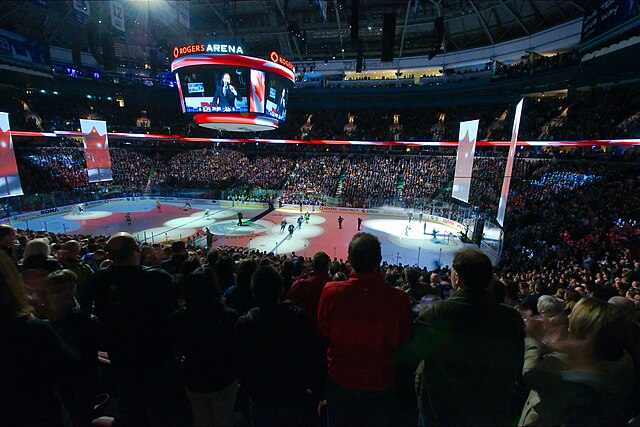
Singing “O Canada” at a Canucks game (Wpcpey / Wikimedia Commons)
What is the first thing that comes to your mind when you think of ice hockey? Big, burly guys fighting for a piece of cylindrical rubber? Or being outside skating on a frozen pond, playing with friends on a cold, chilly day? Well, either one is right!
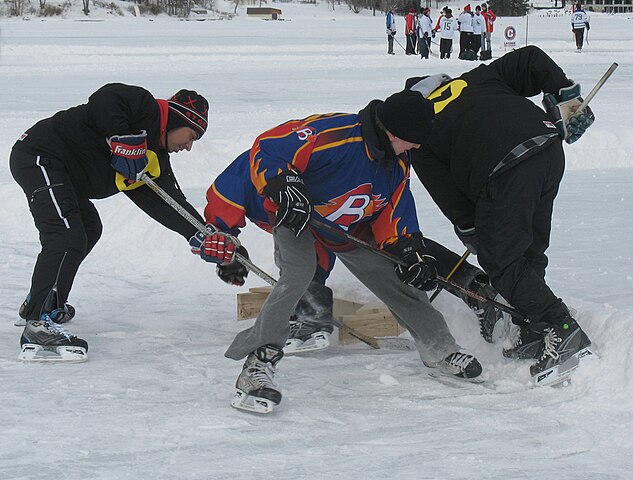
Pond hockey in Quebec (Gilbertus / Wikimedia Commons)
Now if I ask you WHERE was it invented? You would probably say Canada. In this case, you are partially correct. Why do you ask? I’ll get into that as we learn about the history of hockey!
Games involving a stick and some kind of object (be that of a puck or any type of ball) can be traced back to ancient times. Such games were popular throughout Europe. In Ireland, the Irish had their own stick and ball sport, called Hurling. The game had full contact, a penalty box for players who broke the rules and two goal posts on either end of the field, guarded by a goalkeeper. The objective of the game was to hit the small ball called sliotar either over the crossbar for one point or under the crossbar into the net for three points. Hands were allowed in the game to catch and carry the ball for not more than four steps or hit the ball to pass it to a teammate. In the United Kingdom, another stick and ball game was also popular – the game of Field Hockey. Again, this sport involved goalkeepers guarding the goal post at either end of the field, sticks and a small ball. These sports would serve as precursors to ice hockey.

A game of Hurling (Ww2censor / Wikimedia Commons)
When British soldiers and immigrants from Europe first came to Canada in the early 19th century, they brought their stick and ball games with them. They played them on the ice and snow. This is the first instance of hockey being played in Canada.
Ice hockey, as a game, was thought out by James Creighton, an engineering and law student at McGill University in Montreal. Since James already had a side job as a figure skating judge at the Victoria Skating Rink, he played these “informal” games of hockey with the Skating Club members. They planned on March 3rd of 1875 to play a modified version of the game of Shinty, a Scottish stick and ball game, on ice.
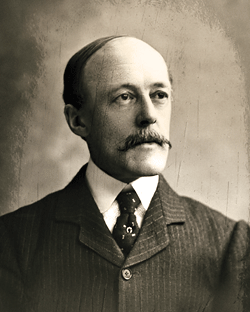
Portrait of James Creighton (File Upload Bot / Wikimedia Commons)
Wanting to expand the game even further, James put an ad in the Montreal Gazette to invite spectators to the game. He wanted the entire city to know about this new game. To prevent any injuries to spectators, he replaced a lacrosse ball with a circular piece of wood. The ad in the Gazette stated the following:
A game of Hockey will be played at the Victoria Skating Rink this evening, between two nines chose from among the members. Good fun may be expected, as some of the players are reputed to be exceedingly expert at the game. Some fears have been expressed on the part of intending spectators that accidents were likely to occur through the ball flying about in too lively a manner, to the imminent danger of lookers on, but we understand that the game will be played with a flat circular piece of wood, thus preventing all danger of its leaving the surface of the ice. Subscribers will be admitted on presentation of their tickets.

Victoria Skating Rink during a hockey game in 1893 (Voyager / Wikimedia Commons)
The game turned out to be a success. The Gazette reported that a large crowd gathered at the Victoria Skating rink to witness the first indoor hockey game. The players included James, his friends from McGill and some members of the Victoria Figure Skating Club. James’ team won the game.
The game ended in a fight. It was not between the players though but between the players and spectators and other members of the Victoria Figure Skating Club, who thought that the game was taking away their practice time and ruining the ice quality. Newspapers in Ottawa and Kingston reported that “shins and heads were battered, benches smashed and the lady spectators fled in confusion.” This was the first recorded hockey fight.

The Rideau Hall Rebels in 1889. James is seated third from left. (Hantsheroes / Wikimedia Commons)
In 1880, James graduated from McGill with a bachelor’s degree in Common Law. After moving to Ottawa to work as a lawyer, he became a law clerk for the Canadian Senate. It was during this time that James created the Rideau Hall Rebels, a team consisting of Parliamentary employees. It was around this time that James’ game was becoming well known in Quebec and Ontario. After playing some games around Ottawa and becoming well known, he befriended Edward and Arthur Stanley, sons of the Governor-General of Canada Lord Frederick Stanley. With James’ influence, both Edward and Arthur became avid hockey fans and players. Their parents, Lord Stanley and his wife supported their sons’ new hobby and soon decided to donate a new trophy in support of amateur hockey. After visiting the Montreal Winter Festival and seeing hockey being played for the first time, Lord Stanley purchased a silver bowl as a trophy and named it the Dominion Hockey Challenge Cup, which was to be presented to the best team in Canada. The Cup was later renamed as the Stanley Cup, which is now awarded to the winners of the National Hockey League (NHL) postseason.
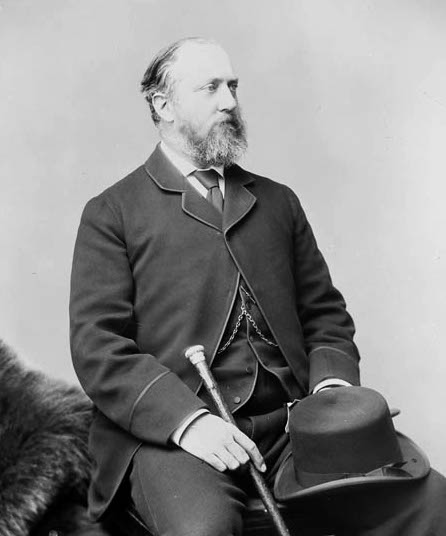
A portrait of Lord Stanley of Preston (Materialscientist / Wikimedia Commons)

The Stanley Cup (Shizhao / Wikimedia Commons)
Around the turn of the 20th century, professional hockey started developing south of the Canadian border. Across Canada’s Lake Superior in the American state of Michigan, talks were being held to establish a professional league known as the International Professional Hockey League (IPHL) in the city of Houghton. Prior to these talks, professional hockey was generally frowned upon by hockey organizations, who favoured amateurism. Talks of professional hockey started when a team from Pittsburgh, Pennsylvania, playing in the Ontario Hockey Association (OHA), were caught paying their players. The OHA immediately banned all teams from the state of Pennsylvania. This caused teams in Pennsylvania, who wanted hockey as their full-time job, to talk with other American based teams into creating a league that paid their players.
After the formation of the IPHL in 1904, major hockey leagues in Canada started transitioning from amateur leagues to professional organizations, where players were paid. Many organizations (including the IPHL) folded due to the demands for players asking for more pay, leaving the Eastern Canada Hockey Association (ECHA) as the only professional league left. They were able to succeed due to a silver mine boom in northern Ontario. Mines in the area hired professional players to play on their teams and with the boom, they were able to pay their players.
By 1910, the mining towns had so many professional players on their teams and demanded to compete for the Stanley Cup. The Cup, however, was only awarded to amateur teams. The ECHA rejected this idea, so the mine owners, angry that their plan did not work, formed the National Hockey Association (NHA). It was during this time that, due to players wanting more money, teams implemented a salary cap. This resulted in disorder in the NHA, which led to most teams folding.
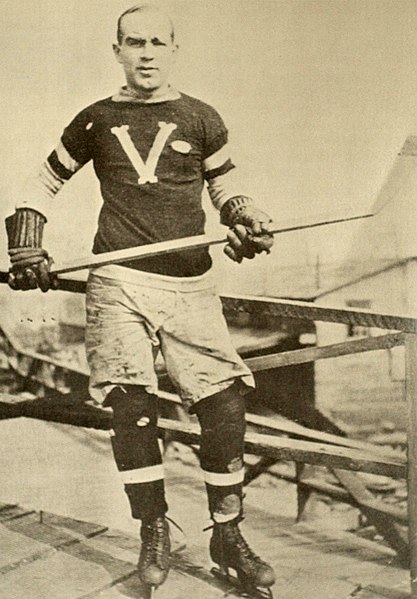
Cyclone Taylor during his tenure with the Vancouver Millionaires of the PCHA (Kaiser matias / Wikimedia Commons)

Hugh Lehman during his tenure with the New Westminster Royals of the PCHA. (Fairhop / WIkimedia Commons)
With the NHA on its last legs, the Patrick brothers, who played in the league before its demise, moved west to form the Pacific Coast Hockey Association (PCHA) in British Columbia. In doing so, many well known NHA players, like Cyclone Taylor and Hughie Lehman, signed with teams out west. With six teams left in the NHA, they competed with the PCHA for players to join their teams. Both NHA and PCHA teams met at the end of the season for the Stanley Cup Final, a tradition that started in 1915. The NHA finally suspended operations in November of 1917. This led to owners transitioning to form what is known today as the National Hockey League (NHL). The tradition of a Western Canadian hockey team playing against an NHL team in the Stanley Cup Final ended in 1926 when the Western Hockey League (a league with both PCHA and Western Canada Hockey League teams combined) was forced to cease operations as many arenas were competing for players in the NHL.
During the Great Depression and the Second World War, the NHL lost many teams, reducing the league to what is known today as the “Original Six”. These teams are:

Toronto Maple Leafs (Sabbatino / Wikimedia Commons)
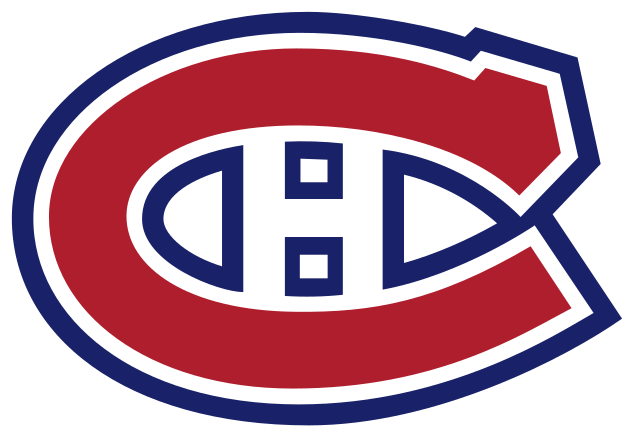
Montreal Canadiens (Sabbatino / Wikimedia Commons)

Detroit Red Wings (Sabbatino / Wikimedia Commons)

New York Rangers (Sabbatino / Wikimedia Commons)

Boston Bruins (Sabbatino / Wikimedia Commons)

Chicago Blackhawks (Corkythehornetfan / Wikimedia Commons)
During the 1950s, ice hockey games were being broadcasted on television in Canada. With Hockey Night in Canada on Canada’s public broadcaster, the Canadian Broadcasting Corporation (CBC), the attendance of many small professional leagues’ attendance, including that of the QHL, dropped as more and more people preferred to watch the games on television. This forced many small professional leagues to fold.

The Vancouver Canucks very first logo when they were part of the Western Hockey League from 1945 – 1970 (Stuart lyster / Wikimedia Commons)
Meanwhile, a minor hockey league, known as the Western Hockey League (no relation to the previous league that folded) was formed on the west coast. The Western Hockey League (new WHL) included teams like the Vancouver Canucks, the Tacoma Rockets, Seattle Totems, New Westminster Royals and the Los Angeles Blades. The players in this new league had the skill and talent as those in the NHL, thus making these teams seem important to many hockey fans with the hope that they might overpower NHL teams. Unfortunately, as the NHL increased the number of teams in its league, the new WHL lost the competition and had to fold. However, in 1970, just three years before that happened, the Vancouver Canucks moved to the NHL.

The World Hockey Association (Connormah / Wikimedia Commons)
In 1971, Dennis Murphy and Gary Davidson, two American promoters, wanted to create a league that rivalled the NHL. They created the World Hockey Association (WHA), which had teams located in markets that did not have any NHL teams. Cities like Edmonton, Winnipeg, San Francisco and Quebec City were awarded teams. Unfortunately, the league suffered from many problems a year after it was founded. Many teams suffered financial hardships due to lack of funding and had to be relocated four or five times. Other teams, like the Jersey Knights, played in arenas that were not suitable to any professional sporting standards. For example, their arena, the Cherry Tree Arena in New Jersey, did not have dressing rooms. Players had to face the inconvenience of having to change in the Holiday Inn Hotel three kilometres away and be driven to the arena for games and practices. In addition to the inconveniences, the arena surface was built on a slope, so players had to skate upwards to score goals, making that terribly difficult especially on slippery surfaces.
With all these problems, the WHA closed down and a handful of teams joined the NHL. These included the Edmonton Oilers and the Winnipeg Jets. From the 70s all the way till today, the NHL would see growth with new teams entering the league. As time went on, the number of teams in the NHL grew enormously.
Inspite of its growth, the NHL still faced problems. In 2005, the NHL was forced to cancel its season due to a labour dispute. For the first time in professional sports league history, there were no games played that year. Despite these downsides, the sport of hockey still grows in the culture of Canada. There are 621,026 hockey players in Canada. In 2021, the NHL will be welcoming its 32nd team into play, the Seattle Kraken. This goes to show how widespread hockey has become across North America. From Canada’s British Columbia down to America’s Los Angeles, California and all the way to Miami, Florida, hockey is everywhere! Hockey has developed to be a national pastime.

The logo for the National Hockey League’s newest team, the Seattle Kraken (Saucy / Wikimedia Commons)
The growth of hockey would not have been possible if it was not for a young man with a dream to play a modified traditional game on ice with his friends. Thanks to the brilliant ideas of James Creighton, many Canadians get to enjoy this national pastime now. The game of hockey fills people with exhilarating joy and excitement as they skate on ice with a puck. Nothing gets more Canadian than this! Like what Canadian author Roch Carrier once said in his iconic book, The Hockey Sweater:
The winters of my childhood were long, long seasons. We lived in three places – the school, the church and the skating rink – but our real life was on the skating rink.
Canadians has acquired a lifestyle as what the famous phrase say, “Eat, Sleep and Play Hockey”. Hockey, the Canadian favourite sport, pastime and life!
Watch Roch Carrier’s iconic book come to life in the video below!

